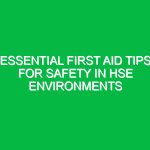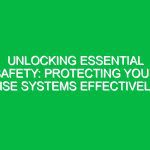Introduction
Good morning, team! Today, we’re diving into an important topic that resonates deeply within our daily operations and overall workplace culture: What Kind of Influence Are You? This Toolbox Talk aims to highlight how each of us can impact health, safety, and environmental (HSE) practices in our workplace. Understanding our influence can significantly enhance our Safety culture, reduce risks, and promote a more positive working Environment.
The Importance of Influence in HSE
Influence can be defined as the capacity to have an effect on the character, development, or behavior of someone or something. In the context of HSE, our influence can determine how Safety protocols are followed, how Hazards are reported, and how we communicate about risks. It is crucial to recognize that our behaviors and attitudes can inspire or discourage others. So, what kind of influence are you bringing to the table?
Understanding Your Influence
Before we explore the various types of influence, let’s reflect on the question: What Kind of Influence Are You? Are you a positive role model, setting an example for others? Or do you inadvertently contribute to negative behaviors? Understanding your influence can help you make conscious choices that promote safety.
Types of Influence in the Workplace
- Positive Influence: This is where you actively encourage others to adhere to safety protocols. For example, if you always wear your Personal Protective Equipment (PPE) and remind others to do the same, you are setting a positive example.
- Neutral Influence: Sometimes, employees may not actively promote safety, but they don’t deter it either. This might be someone who follows safety rules but doesn’t encourage others to do so.
- Negative Influence: This occurs when behaviors or attitudes lead to unsafe practices. For instance, if someone jokes about skipping safety Procedures, it can create an environment where safety is not taken seriously.
Real-Life Examples of Influence
Let’s consider a couple of scenarios to illustrate these types of influence:
Scenario 1: The Positive Influencer
Meet Sarah. She works in our assembly line and always follows safety procedures, including using her PPE and reporting any Hazards immediately. Her consistent behavior encourages her coworkers to do the same. When they see Sarah’s commitment, they feel motivated to prioritize safety, creating a culture of accountability.
Scenario 2: The Negative Influencer
Now, let’s look at Tom. He often disregards safety protocols, believing that he works faster without them. When he skips putting on his Safety Goggles, some colleagues might feel pressured to follow suit. Tom’s influence may lead to increased risks and a potential accident waiting to happen.
Why Influence Matters in HSE
Understanding What Kind of Influence Are You? is vital for several reasons:
- Prevention of Accidents: The majority of workplace accidents stem from unsafe behaviors. When we influence one another positively, we can significantly reduce these incidents.
- Enhanced Communication: Effective communication about safety concerns can prevent misunderstandings and promote a culture of openness.
- Compliance with Regulations: Understanding our roles in influencing safety helps ensure that we comply with Occupational Health and safety regulations, preventing legal issues for both the employees and the organization.
Best Practices for Positive Influence
Now that we’ve explored the importance and impact of influence, let’s look at some Best Practices for fostering a positive influence in our workplace:
1. Lead by Example
Always adhere to safety protocols. Your actions set the tone for what is acceptable behavior. If you follow procedures, others are likely to follow suit.
2. Communicate Openly
Encourage discussions about safety. If you notice unsafe behaviors, address them constructively. Use phrases like, “I noticed you weren’t wearing your helmet; it’s important for your safety,” to encourage compliance without creating defensiveness.
3. Mentor Others
Take the initiative to help new employees understand safety protocols. Sharing your knowledge and experiences can create a more informed workforce.
4. Recognize Positive Behavior
When you see someone following safety procedures, acknowledge their efforts. A simple “Great job wearing your PPE!” can reinforce positive behaviors.
5. Stay Informed
Regularly update yourself on HSE regulations and Best Practices. The more knowledgeable you are, the better you can influence others.
Engagement and Discussion
As we wrap up this Toolbox Talk, I’d like to open the floor for discussion. Here are some questions to consider:
- What types of influence have you observed in our workplace?
- Can you share an experience where someone’s influence positively or negatively affected safety?
- How can we collectively improve our influence on safety practices?
Identifying Hazards and Risks
Part of understanding What Kind of Influence Are You? involves recognizing potential hazards and risks in our work environment. Each employee has a role in identifying and mitigating these risks:
1. Reporting Hazards
Encourage a culture where employees feel comfortable reporting hazards without fear of retribution. When hazards are reported swiftly, they can be addressed before causing harm.
2. Conducting Safety Audits
Participate in regular safety audits. These audits help identify potential risks and ensure compliance with safety Standards.
3. Risk Assessments
Understand the risks associated with your tasks. Engage in risk assessments and think critically about how your actions can influence safety.
Regulations and Compliance
It’s essential to understand that our influence must align with relevant regulations and standards. Familiarize yourself with the Occupational Safety and Health Administration (OSHA) guidelines and our company policies. Compliance not only keeps us safe but also protects the organization legally. Failure to comply can lead to fines, penalties, and increased risks for everyone.
Conclusion
As we conclude this Toolbox Talk, remember that What Kind of Influence Are You? is not just a rhetorical question; it’s a call to action. Your choices and attitudes significantly affect your safety and the safety of your coworkers. By leading by example, communicating openly, and fostering a culture of safety, we can all contribute to a safer and more productive work environment. Thank you for your attention and your commitment to maintaining a safe workplace. Let’s continue to be vigilant and supportive of one another as we move forward with our tasks today.


